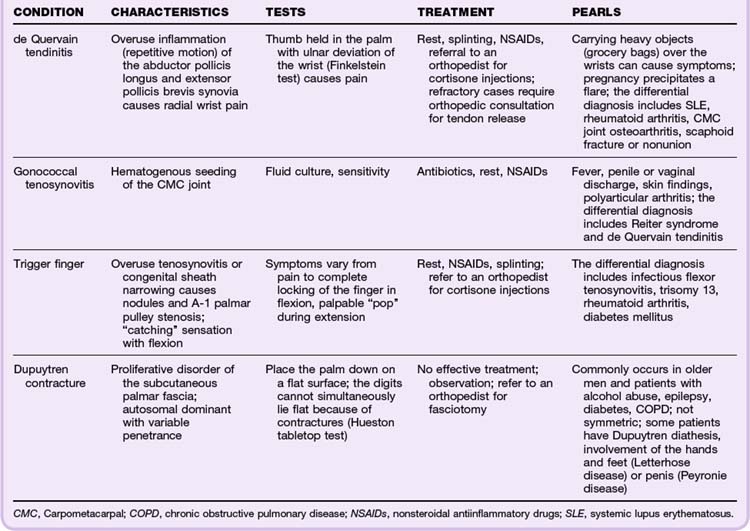86 Tendinitis and Bursitis
• Emergency department treatment of tendinopathy and aseptic bursitis should be initiated conservatively with rest, immobilization of the involved tendon, compression of superficial bursae, and oral analgesia.
• Nonsteroidal antiinflammatory drugs may be useful in providing pain relief for patients with tendinopathy and bursitis but are no longer preferred over other analgesic regimens.
• Other emergency medical conditions such as septic arthritis, suppurative tenosynovitis, septic bursitis, fractures, and rheumatologic conditions should be excluded in the differential diagnosis.
Epidemiology
The incidence of tendinitis increases with age as muscles and tendons lose some of their elasticity, and it is highest in the age group 25 to 54 years. Bursitis affects approximately 1 in 31 (3.2%) or 8.7 million people in the United States. According to the Centers for Disease Control and Prevention, in 2001 tendinitis was responsible for a median of 10 days away from work as compared with 6 days for all cases of nonfatal injury and illness.1 Most cases of tendinitis involved white, non-Hispanic women whose occupations had a highly repetitive component.
Pathophysiology
Most often, tendon injury is caused by chronic overuse resulting in degenerative changes.2,3 The classic inflammatory signs of pain, warmth, erythema, and swelling may sometimes be experienced acutely, although tendinitis is no longer thought to be an inflammatory disorder.4 Bursae may become inflamed for many reasons: chronic friction, trauma, crystal deposition, infection, and systemic diseases (rheumatoid arthritis, ankylosing spondylitis, psoriatic arthritis, tuberculosis, and gout). Because tendons frequently cross over bursae, it is not uncommon for bursitis to be secondary to overlying tendonitis (e.g., supraspinatus tendinitis, subacromial bursitis).
Tendonitis
The signs and symptoms of tendinitis can be quite variable. Pain is the most common complaint of patients with joint problems seen in the ED. Particular attention should be paid to the location of the pain; it can be articular (within the joint capsule), as in septic arthritis, or periarticular (outside the joint capsule), as in tendinitis or bursitis (Table 86.1).
Table 86.1 Clinical Features of Articular versus Periarticular Joint Pain
| CLINICAL FEATURE | ARTICULAR | PERIARTICULAR |
|---|---|---|
| Associated conditions | Septic or other arthropathies | Tendinitis and bursitis |
| Range of motion | Decreased | Preserved |
| Pain | With passive and active motion | Only with certain active movements |
| Fever | Yes | No* |
| Trauma | Fractures | Repetitive use or stress |
| Risk factors | Rheumatoid and psoriatic arthritis, osteoarthritis, crystal arthropathy | Corticosteroid or fluoroquinolone use, connective tissue disease |
| Association with rest | Morning stiffness improves throughout the day | Night pain prevents sleep |
* Exceptions are septic bursitis and suppurative tenosynovitis.
Bursitis
Inflammation of a bursa may be infectious or traumatic, degenerative, or due to underlying systemic disease.5 Risk factors for the development of bursitis are acute trauma, repetitive injury to the painful area, infections, tuberculosis, gout, pseudogout, uremia, and rheumatoid arthritis. The diagnosis is made clinically based on tenderness at a bursal site, swelling of a superficial bursa, and localized pain with motion and at rest. Regional loss of active motion may occur as a result of swelling; however, range of motion should not be affected in patients with aseptic bursitis (see the Red Flags box on tendinopathy and bursitis).
![]() Red Flags
Red Flags
Tendinopathy and Bursitis
Any joint effusion with systemic symptoms is septic arthritis until proved otherwise.
Any injury in a patient with a history of trauma is considered a fracture until proved otherwise.
Pain with passive motion indicates joint involvement; further investigation for an inflammatory or infectious cause is needed.
A history of steroid injection into a large tendon greatly increases the risk for rupture.
Steroid injections or systemic steroids increase the risk for infection.
Fluoroquinolone use increases the risk for tendonitis and tendon rupture.
Presenting Signs and Symptoms
Shoulder
Supraspinatus Tendinitis/Impingement Syndrome
Because of its complex structure and extensive range of motion, the shoulder is a joint predisposed to overuse injuries. The muscles of the rotator cuff (supraspinatus, infraspinatus, teres minor, subscapularis) and the glenohumeral ligaments serve to stabilize the joint. Impingement of these tendons occurs because of their position between the humeral head and acromion, which predisposes to chronic tendinosis6,7 (Table 86.2). Impingement syndrome is the number one cause of shoulder pain. It occurs in three progressive stages that worsen over time. Testing and staging of impingement syndrome are reviewed in Table 86.3.
Subacromial Bursitis
The subacromial bursa lies under the acromion and coracoacromial ligament, to which it is attached. This bursa separates the ligament from the supraspinatus muscle and rotator cuff. Subacromial bursitis is thus thought to be an extension of supraspinatus tendinitis and typically follows this disorder’s stages of impingement. Pain and tenderness are localized to the lateral aspect of the shoulder, and signs of impingement are noted on physical examination (see Table 86.3).
Elbow
Lateral and Medial Epicondylitis
The lateral and medial epicondyles are commonly injured as a result of repetitive use (Table 86.4). Pain often begins as a dull ache that increases with the inciting activity. Approximately 50% of tennis players will experience lateral epicondylitis, although less than 5% of those with the syndrome play tennis. Radiographs may be helpful in atypical or prolonged cases to exclude rare pathologic conditions such as tumors.8
Wrist and Hand
The wrist and hand are composed of several tendons that pass through thick, fibrous retinacular tunnels. Overuse syndromes are thought to result from degenerative changes in the synovial lining between these tendons and the retinaculum (Table 86.5).
![]() Red Flags
Red Flags
Suppurative Tenosynovitis
Infection of the closed synovial sheaths of the flexors (rarely extensors), often of the fingers and hand
Usually caused by trauma, with the type of bacteria depending on the traumatic exposure (bite wound, puncture, skin flora)
Stay updated, free articles. Join our Telegram channel

Full access? Get Clinical Tree










